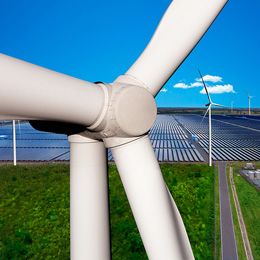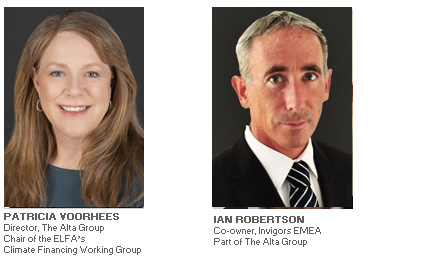
As the equipment leasing and finance industry continues to explore solutions for climate equipment finance, one thing is clear: This is a fast-growing domain that promises both opportunity and risk.
It’s an interesting time, as the global pursuit of a clean-energy economy drives massive investment and innovation in new technologies to cut planet-warming emissions. Bold efforts by governments have resulted in legislation to provide tax breaks and other incentives for infrastructure development and energy transition from fossil fuels.
Equipment finance and leasing professionals looking to capitalize on this enormous opportunity must evolve with the industry as it becomes a bigger part of the overall equipment investment market. But embracing this new domain requires careful consideration and commitment to a strategy to identify and manage associated risks, which may range from technology performance to longer tenors to regulatory constraints.
It's important to note that the climate finance opportunity for the leasing industry falls outside the project finance level, which is traditionally the domain of banks. Utility-scale renewable projects, for example, are outside the industry’s scope of business.
Commercial Viability
What will be successful in this emerging marketplace? That’s a critical question facing equipment finance companies throughout the world as they consider the potential demand for new technologies, along with cost, competition and other factors.
We are dealing with a new animal here, so to speak. While older, established technologies may have a predictable life cycle and maintenance requirements established by the OEM, there are a number of unknowns when it comes to climate-focused equipment. And new tax incentives may be based on per-unit measures.
In many cases, new technologies are being developed by early-stage companies with little or no track record. Oftentimes it’s not just the product or system that is brand new; it’s the entire ecosystem supporting it.
While billions of dollars are being invested in research and development, determining the viability of a product or service can present a challenge. It is important to keep in mind that among climate-focused equipment, there is a spectrum of how proven the viability the business model is in various equipment categories. For example, energy-efficient LED lighting is what we might call a “no-brainer.” It’s proven technology that is very cost-effective, with great green credentials, and is typically financeable. Battery storage, on the other hand, is an evolving area. This fundamental technology is developing quickly. It promises to be a big market that cuts across many different use cases—so it’s not something to ignore—but it will require a high level of risk and market assessment in the near term.
Electric vehicles and charging units, meanwhile, have seen significant growth but availability remains an issue. Demand currently outstrips supply, from commercial fleets to over-the-road tractor trailers to vocational vehicles.
Other climate equipment categories are:
- Photovoltaic cells (PVCs) and related solar-energy equipment
- Wind turbines
- Bioenergy
- Hydrogen
- Water filtration
- Carbon capture, utilization and storage (CCUS)
- Energy-efficient HVAC systems
- Smart technologies for energy efficiency in buildings, agriculture and industrial processes
We have observed that many finance companies adhere to what they know, but it can be helpful to have an external, unbiased perspective to challenge the status quo.
To build successful climate equipment finance strategies, many companies will need to augment their capabilities in risk assessment, legal resources (to understand the many national and local rules governing subsidies and tax credits), and to provide market research.
Inflation Reduction Act: A Watershed Moment in the U.S.
The Inflation Reduction Act (IRA) provides direct incentives to facilitate the conversion to clean energy, including tax credits and grants for manufacturers, installers and investors. This watershed legislation is expected to drive significant reductions in emissions and may go a long way toward helping the U.S. to achieve its climate goals.
As reported by the Climate Finance Working Group of the Equipment Leasing and Finance Association (ELFA), the IRA opens the door to a wider variety of investors and provides significant production and investment tax credits. These include $10 billion in the industrial sector with tax incentives for clean-energy manufacturing (think products such as solar panels, wind turbines or battery storage), industrial facility emissions reductions of at least 20 percent and critical minerals. There are also tax credits for clean hydrogen, electricity and vehicles as well as per-unit tax credits for clean components in solar, wind, batteries, inverters and critical minerals.
In the U.S., the IRA represents the largest climate and clean-energy investment in U.S. history. Businesses will need to ensure they have informed advisors to fully understand the eligibility criteria for qualifying equipment, the timing of individual loan and grant programs and other factors that are essential to accessing this historic public investment.
We anticipate the IRA will accelerate and enhance opportunities in our industry while promoting technology deployment that, for example, can address data needs to enable forecasting and per-unit measures.
Asset Management
One piece of the sustainability puzzle that many countries are pursuing or may pursue in the future is a drive to extend the useful working life of certain types of equipment. This brings greater focus to the need for effective asset management, which is already front and center in decision making by equipment finance professionals because of the technology risk and fluctuating asset values. Among the many key questions to keep in mind are:
- How deep is the secondary market?
- What happens if a company is unable to redeploy an asset in a market due to legislative changes?
- What are the legal, tax and regulatory compliance implications?
Effective asset management over the equipment’s life cycle can help to minimize waste and the environmental impact. Oftentimes, energy-efficiency projects and go-to-market models are more predicated on cash-flow finance rather than the underlying remarketing or redeployment value of the equipment. That represents a significant shift, depending on the company, in terms of how to structure transactions but also the evaluation methodology.
Industry professionals are already noting increased demand across various asset types for circular economy solutions. That is, how can the technology be redeployed for a second and perhaps third life? This may require a different level of exploration to understand new types of equipment and develop financing models.
Gaps in Competencies
The dynamic and growing market for climate finance solutions has uncovered competency gaps. Three key areas are credit underwriting strategy regarding finance tenor, supporting asset management skills and understanding of the requirements to take advantage of IRA incentives. There is growing demand by some companies for longer finance terms than the current average finance length of three to five years. Lessees may seek longer-term financing, sometimes 10 to 20 years, for renewable-energy equipment with longer life cycles. These longer asset lives require adjustments in credit strategy for longer-tenor transactions and supporting asset management. Understanding the nuances and requirements of IRA tax credits for eligible finance transactions is a critical competency in scarce supply.
Expect our industry to consider a shift to extended terms, which would introduce a different risk horizon, and asset-management horizon, than previously. Certain businesses will continue to limit the tenor of a contract that they will accept; this may disqualify them from serving certain markets.
As you delve deeper into climate equipment finance, you may discover a need for strategic partners. One option is to partner with new or existing equipment vendors to create financing structures that share the risks and rewards. Other lessors may choose to purchase or become minority funding participants in contracts with honorable originators to learn typical structures, pricing and documentation.
Readers may also read part one in this series:
Climate Sector Strategy to Seize Equipment Finance Opportunity
